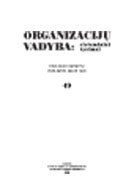Paslaugų produktyvumo koncepcija
CONCEPT OF SERVICE PRODUCTIVITY
Author(s): Jolanta ŽemgulienėSubject(s): Economy
Published by: Vytauto Didžiojo Universitetas
Keywords: produktyvumas; efektyvumas; productivity; efficiency
Summary/Abstract: Discussions in scientific literature (Sahay, 2005, Nachum, 1999, Vuorinen et al, 1998, Parasuraman, 2002) show the attempts to discuss the concept of productivity and define some productivity measurement instrument for service organisations. A. Parasuraman proposed a conceptual framework for understanding the interplay between service productivity and quality (Parasuraman, 2002). R. Johnston and P. Jones suggest productivity consists of two distinct perspectives – operational productivity and customer productivity (Johnston, Jones, 2004). B. S. Sahay proposed multi-factor productivity measurement model. This model is based on static and dynamic productivity parameters and developmental factors’ indicators, such as business development index, research and development index, standardization index (Sahay, 2005). Ch. Gronroos and K. Ojasalo developed a service productivity concept, based on three elements - internal efficiency, external efficiency and capacity efficiency (Gronroos, Ojasalo, 2000). Service productivity problem discussed in this article focuses on the productivity concept issues. The aim of the article is to elaborate the service productivity model as the reasoning for the deeper analysis of service productivity measurement issues in various service groups. The research method is logical analysis of scientific literature. The author suggests the productivity model based on the balance of cost efficiency, customer value efficiency and interrelationship between efficiency, provider – customer encounter and demand. Cost efficiency is considered as a ratio between output and input; it measures how effectively resources are transformed into output. Customer value efficiency is defined as the ratio between the amount of high perceived service quality output (output of high customer value) and inputs used by service provider and customer. Measure of customer value efficiency consider interrelationship between productivity and quality. Customer - provider encounter and demand influence the service processes and utilization of operations capacity. Categorical variable of provider – customer encounter is dependent of service process design, nature of customer – provider communication, duration of customer – provider contacts. Categorical variable of demand reflects character of service demand deviations. Provider – customer encounter is ensured by the number of service organizations and customer’s inputs. Physical environment and intangible input of service organization provides an opportunity to perform appropriate service procedures. Customers usually give inputs (information, activities) to produce the service as well. In addition, provider – customer encounter is a means of transformation of provider’s inputs into results, which meet customer’s needs. Therefore, the provider-customer encounter has the influence on the way of transformation of provider’s and customer’s inputs into the customer’s value. The efficient use of capacity in ser
Journal: Organizacijų vadyba: sisteminiai tyrimai
- Issue Year: 2009
- Issue No: 49
- Page Range: 125-136
- Page Count: 12
- Language: Lithuanian

